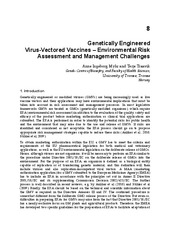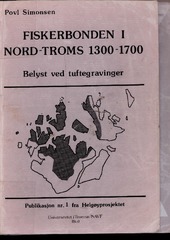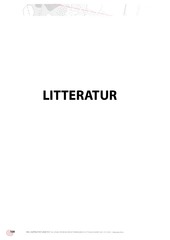Norges arktiske universitetsmuseum: Recent submissions
Now showing items 401-420 of 426
-
Genetically Engineered Virus Vaccine Vectors: Environmental Risk Management Challenges
(Journal article; Tidsskriftartikkel; Peer reviewed, 2011) -
Barents Virtual University? : plans, problems and possibilities
(Conference object; Konferansebidrag, 2001)The international introduction of Internet during the last 8-10 years has resulted in a reorganisation of the IT-sector. This change is overwhelming, to an extent only few experts could predict.Several influential policy reports recently have argued that our societies are changing from industrial societies into 'information societies', in which the creation and dissemination of knowledge is of ... -
Monument og minne. Mobilisering av fortid - argument for fremtid?
(Journal article; Tidsskriftartikkel; Peer reviewed, 2007)In 1977 a monument in memory of the Finnish immigrants was erected in Vadsø, the capital town of the county of Finnmark. The unveiling ceremony of the monument was an exceptional event, where the Norwegian king Olav, the Swedish king Carl Gustav and the Finnish president Uhro Kekkonen attended. The purpose of the monument was to pay tribute to the Finnish immigrants and their contribution to the ... -
Kvendrakten : om å kle seg kvensk.
(Journal article; Tidsskriftartikkel, 2008)Denne artikkelen har fokus på hvordan og hvorfor kvendrakten ble skapt. Hvordan skriver skapelsen av denne drakten seg inn i norsk folkedrakt- og bunadtradisjon? Klær har mange funksjoner, men i denne sammenhengen vil jeg se på det visuelle og identitetsskapende aspektet ved bekledning. -
Kven culture and history in museum terms
(Chapter; Bokkapittel, 2008)In this article I look more closely at how Kven culture and history gained their place in museums and what processes led to the foundation of these museums. In addition, I shall attempt to identify how Kven culture and history have been portrayed and which accounts of the Kven have been presented by these museums. In this context it is instructive to look more closely at why these museums may be ... -
Synthetic Aperture Focusing of Ultrasonic Data From Multilayered Media Using an Omega-K Algorithm
(Journal article; Tidsskriftartikkel; Peer reviewed, 2011)The synthetic aperture focusing technique (SAFT) is used to create focused images from ultrasound scans. SAFT has traditionally been applied only for imaging in a single medium, but the recently introduced phase shift migration (PSM) algorithm has expanded the use of SAFT to multilayer structures. In this article we present a similar focusing algorithm called multi-layer omega-k (MULOK), which ... -
Virological and serological surveillance for type A influenza in the black-legged kittiwake (Rissa tridactyla)
(Journal article; Tidsskriftartikkel; Peer reviewed, 2011)The epidemiology of avian influenza viruses (AIVs) in gulls is only partially known. The role of the world's most numerous gull species, the black-legged kittiwake (Rissa tridactyla), as a potential AIV reservoir species has been unclear. The prevalence of AIV and humoral response against AIV were therefore studied in a colony of apparently healthy black-legged kittiwakes breeding in a nesting cliff ... -
Trans-Atlantic genetic uniformity in the rare snowbed sedge Carex rufina
(Journal article; Tidsskriftartikkel; Peer reviewed, 2011)The red-listed, amphi-Atlantic sedge Carex rufina is highly specialized to certain alpine snowbeds, and threatened by current changes in snow cover duration and moisture conditions. Here we address its range-wide genetic diversity, history, and conservation using amplified fragment length polymorphisms (AFLPs). Despite extensive primer testing, we detected very low overall diversity (4.1% polymorphic ... -
Exitomelita sigynae gen. et sp. nov. : a new amphipod from the Arctic Loki Castle vent field with potential gill ectosymbionts
(Journal article; Tidsskriftartikkel; Peer reviewed, 2011)The newly discovered deep-sea hydrothermal vent field “Loki’s Castle” at 2,350 m depth at 70°N on the Knipovich Ridge north of the island Jan Mayen is the only known black smoker field from the Arctic Ridge system. This vent field holds a unique fauna clearly distinct from vent sites along the Mid-Atlantic Ridge south of Iceland. In addition to numerous maldanid and ampharetid polychaetes one animal ... -
Avipoxviruses : infection biology and their use as vaccine vectors
(Journal article; Tidsskriftartikkel; Peer reviewed, 2011)Avipoxviruses (APVs) belong to the Chordopoxvirinae subfamily of the Poxviridae family. APVs are distributed worldwide and cause disease in domestic, pet and wild birds of many species. APVs are transmitted by aerosols and biting insects, particularly mosquitoes and arthropods and are usually named after the bird species from which they were originally isolated. The virus species Fowlpox virus (FWPV) ... -
Orthopoxvirus DNA in Eurasian Lynx, Sweden
(Journal article; Tidsskriftartikkel; Peer reviewed, 2011)Cowpox virus, which has been used to protect humans against smallpox but may cause severe disease in immunocompromised persons, has reemerged in humans, domestic cats, and other animal species in Europe. Orthopoxvirus (OPV) DNA was detected in tissues (lung, kidney, spleen) in 24 (9%) of 263 free-ranging Eurasian lynx (Lynx lynx) from Sweden. Thymidine kinase gene amplicon sequences (339 bp) from ... -
Optimal foraging in chick-raising Common Guillemots (Uria aalge)
(Journal article; Tidsskriftartikkel; Peer reviewed, 2011)The Norwegian population of the Common Guillemot Uria aalge has declined by > 95% since the 1960s, and is classified as critically endangered in the Norwegian Red List. Much of the recent decline has been attributed to reduced food availability, but without extensive documentation of adult diet. Instead, chick diet has been considered a proxy of adult diet during the breeding season in many Norwegian ... -
Recent decline in body condition of departing Common Guillemots Uria aalge at Hornøya, North Norway
(Journal article; Tidsskriftartikkel; Peer reviewed, 2010)Since 1980, there has been large variation and a recent decline in the mass and body condition of Common Guillemot Uria aalge chicks departing from the nest site in NE Norway. This may be related to deterioration in the feeding conditions off the colony and is alarming considering the critically endangered status of the species in Norway. To measure body condition, earlier studies have caught, weighed ... -
Fiskerbonden i Nord-Troms 1300-1700 : belyst ved tuftegravninger
(Research report; Forskningsrapport, 1980) -
Early Silurian brachiopods (Rhynchonellata) from the Sælabonn Formation of the Ringerike district, Norway
(Journal article; Tidsskriftartikkel; Peer reviewed, 2006) -
Epiphytic macrolichens in spruce plantations and native birch forests along a coast-inland gradient in North Norway
(Journal article; Tidsskriftartikkel; Peer reviewed, 2010) -
FV 53 Kroken - Tønsnes, Tromsø kommune : rapport fra arkeologiske undersøkelser 2008
(Research report; Forskningsrapport, 2009) -
Tønsnes havn, Tromsø kommune, Troms : rapport fra arkeologiske utgravninger i 2008 og 2009
(Research report; Forskningsrapport, 2010)Utgravningene av totalt elleve lokaliteter på Skarpeneset i 2008, med et begrenset tillegg i 2009, avdekket overraskende fire store, rektangulære tufter, mer eller mindre nedgravde i bakken, på to av lokalitetene. Tuftene er datert samlet til 7000 – 6500/6400 f.Kr. Det foreslås at de er rester etter hus med parvis skråstilte, takbærende stolper, uten markerte ildsteder og med minst to åpninger/innganger. ... -
Den første gården i Nord-Norge : jordbruksbosetting fra bronsealder til jernalder på Kveøy
(Research report; Forskningsrapport, 2010-06) -
Undersøkelsene på Melkøya : Melkøyaprosjektet - kulturhistoriske registreringer og utgravninger 2001 og 2002
(Research report; Forskningsrapport, 2009)


 English
English norsk
norsk


















